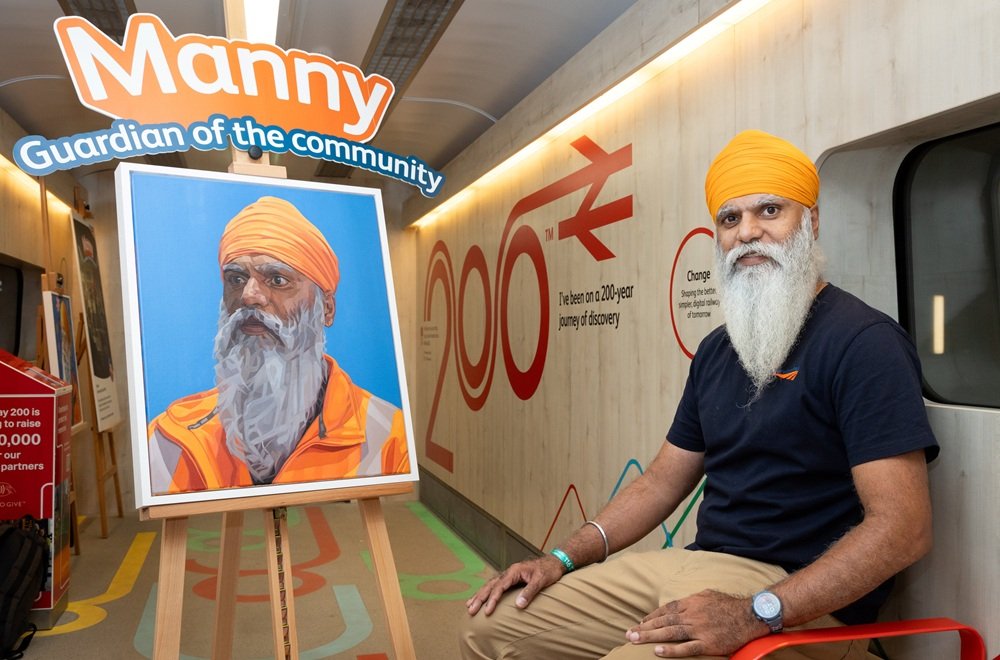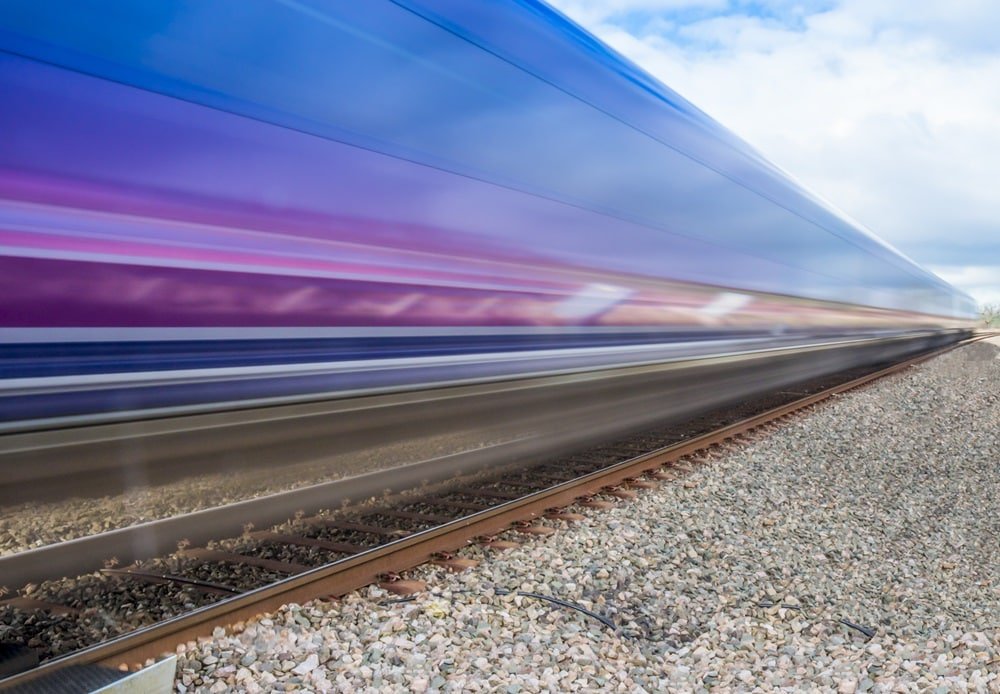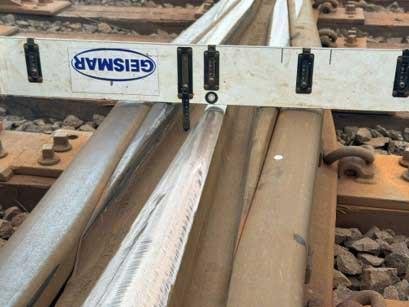Rail & Road
Portrait of Network Rail ‘hidden hero’ Manny unveiled on exhibition train

A portrait of a much-loved rail industry employee has been unveiled at London Euston station.
Network Rail said the painting of Manny Kang celebrated the “exceptional care and commitment” he brought to his role as a Community Safety Manager on the Central route, connecting the West Midlands and London.”
The special portrait went on display for one day only, forming part of the ‘Partner Zone’ coach of the Railway 200 exhibition train named Inspiration.
Curated in partnership with the National Railway Museum, Inspiration will visit a number of locations on Britain’s rail network until summer 2026. The touring exhibition aims to attract the next generation to consider a career in rail, with a range of engaging display themes from ‘Railway Firsts’ to ‘Your Railway Future’.
Network Rail said community safety managers like Manny played a “vital role” in helping to deliver a safe and reliable railway. This includes going out to local schools and community groups supporting the public to understand the dangers of trespassing on the railway, keeping them safe and trains on the move. Outside work, Manny has raised thousands of pounds for Dementia UK by completing sporting challenges and running ‘Samosa Saturdays’ outside his local football ground.
Manny Kang, Community Safety Manager, Network Rail, said: “If you’d asked me nearly 25 years-ago when I joined the railway that I would have an amazing portrait displayed to the public, I would never believe you.
“I’m incredibly proud to be a part of this project. Community safety managers work really hard behind the scenes helping to keep the public safe and trains running on time. I hope the portrait helps to inspire others to consider a career in rail, as it can open so many opportunities.”
The portrait, painted by acclaimed artist Duncan Shoosmith – winner of the Sky Arts Portrait Artist of the Year 2019 – was the result of Network Rail’s recent Hidden Heroes campaign. The campaign highlights the vital work rail employees do to keep the network running with a total of over 1.7 billion journeys made by rail passengers in Great Britain in the last year alone.
Duncan Shoosmith, Portrait Artist of the Year Winner 2019, said: “I am delighted to support this project and shine a light on some of the unseen faces who put so much care into their work. As someone who regularly uses trains for art galleries and sittings, this seems a fitting way to celebrate the workers who keep the network running. Part of the joy of a portrait is to elevate the sitter as a subject of social importance for posterity and I can think of no better subject on this occasion than Manny.”
To discover more information about careers at Network Rail visit https://www.networkrail.co.uk/careers/
Rail & Road
Kineco acquires UK rail componentsfirm, its second int’l deal in 10 months | Goa News
Panaji: The Goa-based Kineco Group has acquired TRB Lightweight Structures(TRBLS) — a UK supplier of lightweight components to rail majors, including Hitachi and the London Underground — for an undisclosed price.The acquisition will be housed under Kineco Global Rail, the group’s rail interiors business. This is the company’s second international deal after the purchase of Danish railway sanitation systems firm Semvac AS in Dec.“The acquisition of TRB Lightweight Structures is aligned specifically to the long-term strategic roadmap of our rail-focused brand—Kineco Global Rail. TRB’s legacy and deep expertise in lightweight rail interiors make it a perfect strategic fit. Importantly, both TRB and Semvac combined will now be able to ride on the back of Kineco Global Rail’s large engineering and manufacturing infrastructure in Goa, which is entirely dedicated to the rail interiors market,” said Kineco Group MD and chairman, Shekhar Sardessai.TRB, based in Huntingdon, UK, has over 70 years of experience in manufacturing lightweight components for rolling stock manufacturers in Europe and Asia. Under the agreement, the company will continue to operate under its brand name and maintain its UK manufacturing base.Its MD, Paul Colquitt, said the partnership would allow the firm to sharpen its focus on the rail sector while retaining its identity and operations in the UK.Kineco said the acquisition supports its plan to consolidate niche rail interior brands under one umbrella, as it positions itself to scale in global markets.
Rail & Road
Government provides £5m funding for 26 innovative rail projects to boost passenger experience

Twenty-six cutting-edge projects that aim to improve passenger experience on the railway have launched as part of Innovate UK’s First of a Kind competition. The projects are being supported by a multimillion funding package by the Department for Transport (DfT).
The First of a Kind competition is run in partnership with Innovate UK, working closely with Network Rail and train operators. It offers grant funding for innovative projects to be tested on the railway, to give them a better chance at being bought by train operators, freight companies and Network Rail.
Given the Transport Secretary’s clear direction to “put passengers at the heart of every journey”, this year’s winning projects focus on improving safety at the platforms, passenger safety and reducing incidents of vehicles hitting railway bridges. The DfT said that, with the collaboration of Network Rail and train operators, these innovations would help to “improve rail services and infrastructure where it’s needed most.”
Among the winning projects is IntelliPan Network, which will reduce delays for passengers by using AI to detect faults on overhead lines, eliminating dangerous, service-disrupting dewirements.
Another successful project, SafeRide 5G, will empower passengers to report incidents using their own devices safely and privately via onboard Wi-Fi, boosting response times and removing key barriers to reporting, improving passenger safety.
Twenty-six successful projects will be supported with £5 million in funding from the DfT, which said this boost demonstrated Government’s “commitment to trialling innovative technology to modernise our railway and boost the passenger experience”. It added that the projects would help to deliver better services for passengers, encouraging more people to take the train and supporting growth as part of the Government’s Plan for Change.
Rail Minister Lord Peter Hendy said: “The winners of this competition are taking cutting-edge technology to address some of the biggest challenges facing the rail industry, making a railway that works better for the people and goods using it.
“These innovations are putting safety, reliability and passenger experience first, like IntelliPan Network using AI to detect faults on overhead lines, reducing disruption caused by dangerous dewirements.
“Through this funding, we are building a platform on which innovation can thrive, giving new technologies a chance to succeed and driving economic growth as part of the Plan for Change.”
Previous competition winners are already being used widely across the railways. Amongst them is the Portable Track Geometry Measurement System, which provides immediate track information to engineers to speed up the lifting of speed restrictions or line closures, getting passengers to their destinations quicker.
Mike Biddle, Executive Director for Net Zero at Innovate UK, said: “The innovations receiving support through this competition will contribute to a more accessible, safer, and efficient railway system throughout the UK. The competition highlights the importance of collaboration with industry partners and focuses on delivering high-maturity demonstrations, ensuring seamless integration into the existing railway infrastructure.
“Delivered by Innovate UK, the UK’s innovation agency, on behalf of the Department for Transport, the FOAK rail programme seeks to identify and support outstanding, innovative solutions. Funded organisations will showcase the creativity and impact of their ideas through live demonstrations.”
The twenty-six successful projects have started work on the new technologies, with testing to take place over the coming months.
Rail & Road
From Guesswork to Data-Driven Maintenance: How LRAIL Transforms Rail Inspection | Sponsored

The Challenge: Doing More with Less in Rail Maintenance
Rail operators are under increasing pressure to maintain the safety and reliability of their networks while keeping disruptions to a minimum. The challenge is complex: inspection windows are shrinking, qualified inspection staff are becoming harder to find, and maintenance budgets are under constant pressure. Traditional manual inspections, often carried out on foot with handheld tools, depend heavily on the inspector’s experience and judgment. While experienced crews deliver quality results, human factors such as fatigue, poor weather, and reduced visibility inevitably affect outcomes. This is especially true in complex and safety-critical areas such as turnouts, where small measurement inaccuracies can have serious consequences. In many cases, the data collected during manual inspections is incomplete or inconsistent, making it difficult to move from reactive “fix-when-it-breaks” approaches toward proactive, predictive maintenance strategies. The rail sector increasingly needs inspection technologies capable of delivering fast, consistent, and objective measurements—at full track speed—without compromising accuracy.
Introducing LRAIL: AI-Powered Rail Inspection
Pavemetrics’ LRAIL, now part of the Automated Vision Systems product line within Eddyfi Technologies, was developed to address these exact challenges. This AI-powered, laser-based inspection solution captures accurate, repeatable measurements of all major track components at full track speed. The system combines two high-resolution laser-camera 3D triangulation sensors—manufactured in-house—with integrated inertial measurement units (IMUs) and GPS/INS navigation, enabling the creation of precise, geo-referenced inspection records that can be revisited at any time.
LRAIL automatically detects, classifies, and measures issues such as missing fasteners, irregular ballast profiles, tie degradation, and defects in frogs, switches, and other components—while simultaneously measuring full track geometry parameters—delivering a complete inspection in a single run, without the need for multiple systems, separate passes, or extensive manual follow-up.
A New Standard in Track Inspection
LRAIL redefines what’s possible in railway inspection— especially when it comes to turnouts—among the most complex, costly, and safety-critical track components. Traditionally, inspecting a turnout required slowing down or sending crews on foot for manual walk-throughs, which was time-consuming and left room for inconsistency.
➡ Watch how LRAIL inspects turnouts at full track speed
Operating at track speed, LRAIL captures comprehensive, high-quality measurements of turnouts and all other critical components—including ties, ballast, fasteners, frogs, and switches—in a single high-speed pass. Its integrated system, with perfectly synchronized sensors, ensures that every measurement is taken under the same conditions for maximum consistency.
Operators can define their own grading standards and custom rules, which LRAIL applies automatically and consistently across the network. Geo-referenced outputs in formats such as JPEG, CSV, XML, LAS, and SHP integrate seamlessly into asset management and GIS platforms, enabling teams to quickly pinpoint issues, rank them by severity, and allocate resources where they’ll have the greatest impact.
By turning subjective inspections into precise, consistent data, LRAIL empowers railways to target the right work at the right time and cost—optimizing maintenance, maximizing budgets, and keeping networks moving without disruption.
Real-World Impact: From Two Weeks to Two Days
A recent deployment with a US Class 2 railroad shows how LRAIL transforms inspection speed and data reliability.
Before LRAIL, inspecting a section of track—especially turnouts—took up to two weeks using manual walk-throughs. Inspectors relied on spot measurements at selected points, so results varied by inspector and often left gaps in the record. The process was slow, labor-intensive, and limited in scope, making it harder for planners to see the full picture.
With LRAIL on a hi-rail truck, the same section was inspected in just two days. The system produced a complete digital record of every component—captured to a consistent standard in a single high-speed pass. This detail allowed the maintenance team to base plans on objective, comprehensive data rather than incomplete notes.
The result was not only faster inspections, but a shift to data-driven decision-making: priorities became clearer, budgets more precise, and crews better scheduled.
“We were able to capture our entire single main and east main in record time—over 1.2 TB of high-quality data collected. Using traditional hi-rail methods, this would have taken close to two weeks. With LRAIL, we completed it in just 10–12 hours at track speed. The level of insight we gained in such a short time is truly amazing.”
A Proven Path: Smarter, Faster Rail Maintenance
In an industry where every minute of track time matters, LRAIL is proving that high-speed inspection and uncompromising accuracy can go hand in hand. By delivering complete, geo-referenced data in a single pass, it enables railways to move from reactive fixes to proactive, data-driven strategies—maximizing budgets, improving safety, and keeping trains moving. For operators ready to modernize, LRAIL offers more than just a new tool; it’s a new standard for how rail networks can be inspected and maintained in the years ahead.
Discover how your organization can benefit by visiting www.pavemetrics.com
-

 Brand Stories1 month ago
Brand Stories1 month agoBloom Hotels: A Modern Vision of Hospitality Redefining Travel
-

 Brand Stories1 month ago
Brand Stories1 month agoCheQin.ai sets a new standard for hotel booking with its AI capabilities: empowering travellers to bargain, choose the best, and book with clarity.
-

 Destinations & Things To Do1 month ago
Destinations & Things To Do1 month agoThis Hidden Beach in India Glows at Night-But Only in One Secret Season
-

 Destinations & Things To Do1 month ago
Destinations & Things To Do1 month agoUntouched Destinations: Stunning Hidden Gems You Must Visit
-

 AI in Travel1 month ago
AI in Travel1 month agoAI Travel Revolution: Must-Have Guide to the Best Experience
-

 Family Travel2 months ago
Family Travel2 months agoThings to Do Indoors in New Jersey
-

 Ways to Travel2 months ago
Ways to Travel2 months agoNCT Dream embarks on time-travel adventure in 5th album 'Go Back to the Future' – ABS-CBN
-

 Restaurants & Food5 months ago
Restaurants & Food5 months ago10 New Restaurants In Delhi NCR To Head To This Month
-

 Brand Stories2 months ago
Brand Stories2 months agoVoice AI Startup ElevenLabs Plans to Add Hubs Around the World
-

 Spiritual Travel10 months ago
Spiritual Travel10 months agoIndia Spiritual Train Journey: How train travel is at the heart of growing spiritual tourism in India
